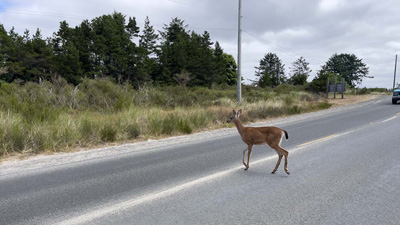After rebounding to pre-pandemic levels in November 2021, the same month's claim frequency in 2022 dropped even lower than during the 2020 lockdown.
Insurance claims for animal strikes inexplicably dipped to pandemic-lockdown levels last November, the Insurance Institute for Highway Safety said in a news release. Will they drop further or spike again in 2023?
The rate of animal-strike-related insurance claims in November is more than twice the yearly average, according to an analysis of claims from 2013 to 2022 conducted by the Highway Loss Data Institute. The peak coincides with mating season, when deer are most active. The fewest animal strike claims typically occur in August.
The severity of claims, measured in dollars insurers pay to cover losses, also climbs during the peak month. The average cost of November animal strike claims over the 10-year period was $4,600, compared with $3,522 for February, the month with the least-severe crashes.
The data do not include information about the type of animal. However, both the timing of the spike in crashes and the greater damage they cause suggest that most of these collisions involve deer, rather than smaller animals.
While the seasonal pattern is familiar, the November 2022 figures present a mystery.
After holding steady for many years, November animal strike claim frequency dropped from 14.1 claims per 1,000 insured vehicle years in 2019 to 12.6 claims per 1,000 insured vehicle years in 2020 as pandemic-related lockdowns dramatically reduced the mileage drivers logged during the peak mating season. An industry measure, an insured vehicle year represents one vehicle insured for one year or two vehicles insured for six months, and so on.
As expected, the November claim frequency rebounded to around the 10-year average in 2021 (13.6 claims per 1,000 insured vehicle years) as the miles people traveled returned to pre-pandemic levels.
Then, as even more workers returned to the office full time and normal life resumed in countless other ways last year, the number of deer strikes plunged once again. November claim frequency, at 11.9 claims per 1,000 insured vehicle years, was even lower than during the 2020 lockdown.
"This is a real head-scratcher," said Matt Moore, senior vice president of HLDI. "Originally, we thought we might get a big spike in November 2021, thinking more deer might have survived the 2020 season. Maybe an increase in hunting prevented that from happening. But that doesn't explain the drop in 2022. It might be related to changes in commuting patterns as people continue to work from home, or we might just be seeing variations in the data. Time will tell."
Monthly travel patterns don't explain the drop. Travel on U.S. roads fell a little more than 1% in November 2022, compared with November 2021, according to the Federal Highway Administration. But the 264 billion vehicle miles logged during the month was still a massive increase over the lockdown period, when drivers logged only 232 billion vehicle miles in November.
It's possible some newer automatic emergency braking (AEB) systems, especially those designed to prevent pedestrian crashes, can also prevent animal strikes. However, the overall number of equipped vehicles is probably still too small to have a noticeable impact, and it didn't change dramatically between 2021 and 2022. In 2022, vehicles equipped with front AEB of any sort accounted for around 23% of the fleet, compared with 18% in 2021.
Better headlights, including curve-adaptive ones, can also help prevent deer strikes. But there was not a big change in the U.S. fleet between 2021 and 2022 with respect to headlights either.
There's also no strong evidence of fewer deer. Hunters killed around 6.2 million deer in 2021, compared with 6.3 million in a record-setting 2020 and around 6 million in 2019, according to the National Deer Association's annual Deer Report. However, state wildlife departments generally believe their deer populations to be stable or increasing, particularly in urban areas.
For the most part, the states with the highest claim frequencies for animal strikes remained the same in November over 2013-22 as in previous analyses. As was the case over 2006-21, West Virginia topped the list with a claim frequency of more than three times the national average, and Iowa, Kentucky, Michigan and Pennsylvania feature high claim rates.
Eight of the 10 counties with the highest November claim frequencies over 2013-22 were in Pennsylvania, with drivers in list-topper Crawford County, in the northwestern corner of the state, filing claims at more than six times the national average for the month. The two other counties were in neighboring New Jersey. All 10 counties had November claim frequencies that were more than twice the national average.
Repairs made necessary by crashes involving deer and other animals are covered by comprehensive insurance, which also covers theft and physical damage from causes other than crashes. Of the 37 companies that report comprehensive coverage to HLDI, only 25 provide information about animal strikes. Over the 10-year study period, that amounted to a total exposure of around 579 million insured vehicle years and more than 3.5 million claims.









